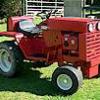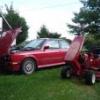By
mattd860
I have developed a kit that allows a Wheel Horse / Toro hydrostatic tractor to be operated by a pedal on the right side of the tractor. The original forward/reverse lever can be retained or removed. The kit includes everything needed to install the pedal kit and installation is simple with the help of a downloadable installation manual. Additionally, only one (1) 1/4" hole will need to be drilled which can be done by a hand drill. No other drilling or cutting will be necessary. Any tractor with this kit can be converted back to stock without any visible evidence that kit was installed. However, you'll never want to do that
The kit operates very simply and similar to modern tractors. When the pedal is pushed forwards the tractor will move forwards. When the reverse pedal is pressed downwards, the tractor will moved in reverse. If the operator takes his foot of the pedal at any time, the pedal will automatically center itself and the hydrostatic transmission will return to neutral (stop). This enables the operator to use both hands on the steering wheel or one hand on the wheel and the other operating an attachment like a snow blower, plow, etc.
The foot pedal is custom cast in Aluminum, uses brass bushings to minimize wear, and it closely matches the OEM Wheel Horse BRAKE pedal commonly found on 8-speed manual transmission tractors. Modifications were done to the pedal to add the reverse pedal and adapt the pedal to the rest of the kit. For the most part, the pedal looks like it was designed and manufactured by Wheel Horse / Toro. Additionally, a grease fitting has been adapted to the pedal to further minimize wear and tear and if the brass bushings ever wear out they are fully replaceable without having to buy a whole new pedal.
The pedal kit fits the following series tractors with Eaton hydrostatic transmissions: C-1X5, 300, 400, 500.
My kit can be adapted to older hydrostatic tractors with the Sundstrand transmission, however, you will need to find an updated hydro cam commonly found on ebay. Message me for more information.
Here is a link where you can download the installation manual: CLICK HERE
I am selling these kits for $330 shipped to anywhere in the United States. I offer multi order discounts as well. I will also sell to other countries for additional shipping charges to be determined.
If anyone has any questions please feel free to PM me or post your question here and I will be glad to help. Or you can email me at mattdarling02@hotmail.com.
Thanks!
Below are pictures of the complete kit and the pedal installed on the tractor. Some modifications have been made since these pictures were taken. For example, the reverse pedal is now cast in aluminum instead of the steel pedal shown below.

 By Thatoneguy
By Thatoneguy By mattd860
By mattd860 By olivertractor
By olivertractor By helpmefixmygt14
By helpmefixmygt14